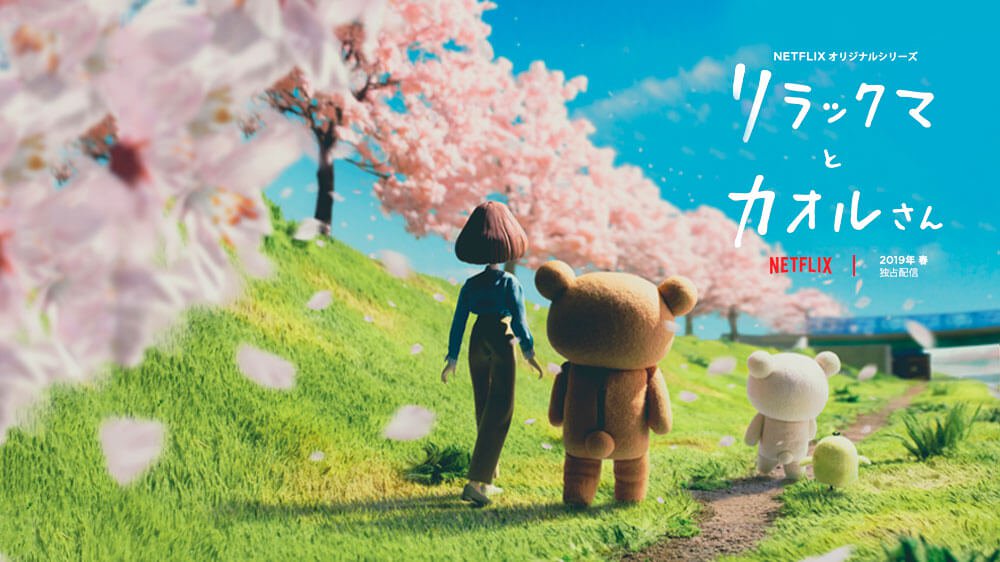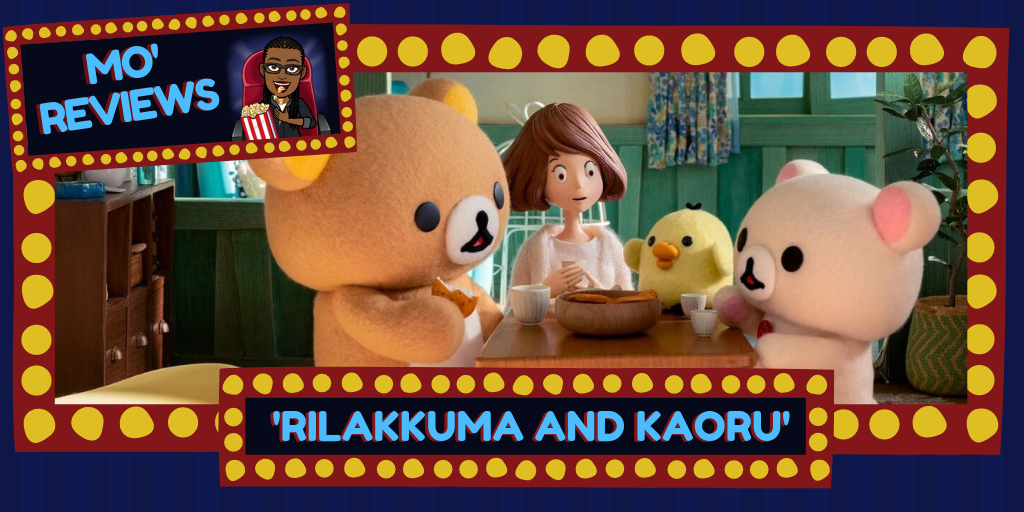Synopsis:
Her life might be a little mundane, but Kaoru gets to go home to Rilakkuma, her endearingly lazy roommate who happens to be a fuzzy toy bear.
Netflix
Monique’s Review:
As I relaxed Easter Sunday, I binge-watched all of Netflix’s new San-X show, Rilakkuma and Kaoru. Filmed by dwarf studios in gorgeous stop-motion animation from that showcases the beauty of Japan’s natural landscape throughout the seasons, Rilakkuma is billed as the show’s main draw. But in actuality, the lazy sentient bear costume is more like the viewer’s entryway into the all-too-relatable life of Kaoru (voiced by Mikako Tabe in the original Japanese version and Lana Condor in the U.S. dub).
Kaoru is a 25-year-old trying to make a way for herself in modern-day Japan. Similar to Sanrio’s animated Netflix offering, the painfully accurate Aggretsuko, Kaoru is struggling with feelings of inadequacy in adulthood. She, like a lot of us young adult women, feel like we are somehow not cut out for living life the way society dictates us to. Kaoru, for instance, is single and laments every moment of it. She feels as if something’s wrong with her because she is serious, non-flashy and is quiet-natured. Meanwhile, her younger co-worker Sayu (voiced by Mai Kanazawa/Melissa Fahn) is fashionable, boo’ed up, and, while always pleasant to Kaoru, is clearly from the “popular girl” mold.
Kaoru could feel disappointed that her only friends are a bear costume, a small toy bear named Korilakkuma, her pet bird Kiiroitori and the neighbor’s young son, Tokio (voiced by Souki Matsumoto/Veronica Taylor). But instead, the series shows how these characters create a quaint and charming family who look after each other and teach each other valuable life lessons. In fact, it’s usually Rilakkuma, Kiiroitori and Korilakkuma teaching Kaoru through their various grunts and cute antics.

So what does Kaoru learn, you might be asking. In 13 short, quirky episodes that span the gamut of surreality (including episodes with a ghost teen and aliens), Kaoru learns, as well as the audience, that living life doesn’t mean being perfect or being the most popular or even the flashiest. What it does mean is to be true to yourself and recognize what you need out of life, not how to fit to society’s definition of life.
Perhaps one of the reasons the show excels at being a visual cup of comforting hot chocolate is because of the series’ writer, Naoko Ogigami. Ogigami’s work has been described as iyashi-kei eiga, or “films that provide emotional healing,” as Frames Cinema Journal’s Colleen Laird points out.
Laird writes that Ogigami is described in Japanese film circles being “imaged as a female director who makes films for women.” Her films are often favorites among women viewers and are noted (and sometimes criticized) for their reliance on natural scenery and composition.
But what some might criticize Ogigami’s work for is exactly what makes her writing style for Rilakkuma and Kaoru work. “While it’s true that her story lines are perhaps understated and that her films feature characters that transform from a state of ennui or dissatisfaction to personal acceptance and emotional peace through accomplishment or ‘healing,’ her films are nuanced and express psychological depth and complexity,” wrote Laird, “not to mention deft comedic timing, that her detractors overlook.”
Indeed, Rilakkuma and Kaoru excels at giving homey slice-of-life storylines within more fantastical and often humorous moments, making the series even more endearing than it already is. Combined with Masahito Kobayashi’s directorial work and dwarf studios’ meticulous artistic skill, Rilakkuma and Kaoru is the perfect show to watch on a lazy Sunday. It’s got the Mr. Rogers effect; it calmly reacquaints you with life while providing engaging entertainment and stunning animation that transports you to spring picnics under the cherry blossom trees, nighttime summer festivals, and idyllic snowy winter days.

One of the most important lessons the show teaches early on is “Every flower blooms in a different period.” We don’t all have to do the same thing at the same time in order to be seen as successful or “normal.” We don’t have to have a husband before 30, the track Sayu is shown to be on as the series progresses. We don’t have to appease our parents, something Kaoru subtly struggles with when her mom (voiced by Barbara Goodson in the U.S. dub) wants her to come home to work on the family’s cherry farm. We can be indecisive and confused, because that is actually curiosity in disguise; ultimately, by trying different avenues, we’ll find our way forward.
I’d say that Rilakkuma and Kaoru and Aggretsuko appeal to the same, overworked, stressed-out audience of Millennials. Young people, women in particular, are facing societal pressures left and right. In Japan, certain pressures are greater, but it’s astounding to me how the same concerns– marrying before 30, settling down, and simultaneously living the “independent woman” lifestyle marketed to us by the media–are saddled to women across the globe. Us young women want to be everything to everyone, but rarely are we taught to mean something to ourselves. We don’t have to live the same Sex and the City life, because how realistic is that life, anyway? Instead of conforming, we should look within to find out who we are and what we want out of life, not what society wants for us.

With that said, both shows also do well regarding their more conforming characters, such as Sayu and Aggretsuko‘s Tsunoda. Instead of villainizing them, the shows paint them as likeable people who just happen to be on their own paths. It just so happens that those paths line up nicely with societal standards. In the case of Tsunoda especially, her “popular girl” persona hides the real truth–a young woman (well…a Thomson’s gazelle) who fronts for Instagram and plays into female stereotypes as a defense mechanism to deal with she and Retsuko’s sexist boss, but is actually just as lost as Retsuko in the stream of adulthood.
However, both programs show how those life paths are just as valid as the nonconformist characters like Retsuko and Kaoru. While they are focusing on the women who feel like outsiders, Sanrio and San-X’s programs also want all their female audience to feel like no matter what path they choose, they are validated in their choices. Refreshingly, like Aggretsuko, Rilakkuma and Kaoru seem to want their female audience to find their confidence in whatever makes them happy, whether that’s getting married or living with stuffed animals until the right person comes along.
Thankfully for Rilakkuma and the rest of the animal friends, it’s assumed that Kaoru just won’t give up her stuffed companions once a possible relationship comes along in the form of Hayate, the local delivery man (voiced by Takayuki Yamada/Chris Hackney). But still, as the show also teaches, things change. Several times throughout the season, it’s subtly alluded that Kaoru will have to give up Rilakkuma and Korillakuma one day (at least, it is to me). But for now, Rilakkuma, Korillakuma and Kiiroitori can have fun keeping their caretaker out of harm’s way as she finds her space in the world.
